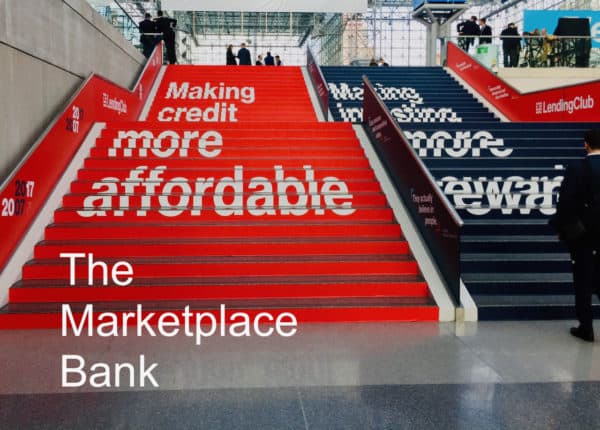
Earlier this week, leading marketplace lending platform LendingClub (NYSE:LC) announced Q3 financial results that beat on both the top and bottom line. Importantly, LendingClub reported its first profitable quarter in years – a longtime goal of the Fintech.
LendingClub went public in December 2014 during the honeymoon period of online lending. LendingClub was the new-shiny of Fintech and the IPO was viewed as a benchmark event for the entire online lending community. The IPO was widely promoted and went to market with a share price of $15.
 LendingClub ultimately sold 66.7 million shares, raising $834 million at an almost $9 billion valuation. On the first day of trading, shares rose as high as $28 settling at the end of the day at $23.
LendingClub ultimately sold 66.7 million shares, raising $834 million at an almost $9 billion valuation. On the first day of trading, shares rose as high as $28 settling at the end of the day at $23.
Since those heady, early days as a reporting company, shares in LendingClub have headed in one direction – down. The dramatic decline in valuation represents a profound destruction in shareholder value. Today, shares in LendingClub trade around $14.50, following a reverse share split of 5 for 1.
Several years ago, LendingClub may have provided a catalyst for a correction in the online lending sector, due to the untimely exit of its founding CEO. At that time the entire US online lending industry received a gut-churning reality check as to whether, or not, the future of lending would be led by Fintechs.
In the ensuing years, LendingClub has fought its way back from a Fintech star, to Fintech has-been, to once again a Fintech of interest. Much of the progress is a credit to the revamped executive team that has ground it out, quarter after quarter, since 2016 as Wall Street watched with skepticism.
This week, following the earnings call, shares in LendingClub traded markedly higher jumping around 11%.
While LendingClub’s profit and improving guidance definitely helped it was probably the discussion of its forthcoming digital bank, first mentioned in the previous quarter, that most likely caused a portion of renewed investor interest.
The digital banking sector is a hot sector of Fintech. Many industry observers expect traditional brick and mortar operations to shift to a mobile dominated service that caters to a generation that hates a trip to the corner bank. But while digital banking may be the future, many traditional banks have struggled to make the transition which remains ongoing. This digital disruption has opened up an opportunity for agile digital banks which can iterate quickly and provide modern services minus the legacy of traditional banking – a legacy that is encumbered by green screen technology and a culture fearful of change that may impact management bonuses. Additionally, those pesky bank branches are really hard to part with.
The UK is, perhaps, the best ecosystem to review when it comes to observing digital banking growth. Names like Revolut, Monzo, N26, Atom Bank, and more, have risen to challenge the big four High Street Banks hoovering a growing amount of banking activity. Some of these digital banks are capturing thousands of new users every day.
Revolut, a bank that claims around 8 million customers, is said to be looking to raise around $1.5 billion in both debt and equity financing at a valuation between $5 and $10 billion. Revolut recently launched its services in both the US and Singapore expanding beyond its European home base.
Monzo, a digital bank with around 3 million customers, recently reported that about 50,000 new customers were signing up each week. By mid-2020, Monzo expects to have 5 million users. This past June, Monzo was valued at £2 billion. (about USD $2.56 billion)
LendingClub’s current market cap is dramatically lower hovering around $1.2 billion – even with the recent gain in share price.
So what happens when LendingClub becomes a digital bank?
During the conference call, LendingClub CEO Scott Sanborn said much of the infrastructure to operate as a bank is already in place. Many of the necessary licenses have already been approved but there are a few remaining which are in process now. Of course, pursuing and receiving a bank charter is a long and arduous task that may take years. To help advance the mission, LendingClub has hired several advisors to assist in the creation of a digital bank.
 Of note, if LendingClub receives a bank charter it will be able to hold deposits – a move that will lower the cost of capital for its lending services – core to the Fintech.
Of note, if LendingClub receives a bank charter it will be able to hold deposits – a move that will lower the cost of capital for its lending services – core to the Fintech.
Crowdfund Insider spoke to someone with knowledge of LendingClub’s plans and they said LendingClub is planning to put its own spin on digital banking by becoming a “Marketplace Bank.” LendingClub already has over 3 million users, a base the Fintech should be able to migrate over to an entire portfolio of financial services. During the earnings call, Sanborn shared that LendingClub received around 53,000 loan applications during the quarter – each day. That’s a big number. About half a million individuals accessed their accounts during September. If LendingClub can turn these same users into bank customers that will be material to their business.
While many digital banks provide branded credit cards – this tends to be very expensive credit. If you look at the Apple Card provided by Marcus (Goldman Sachs) – the lowest rate you can get is 12.99%. That’s pretty steep. A consumer loan product from LendingClub is currently priced at almost half that rate as the spread between consumer loans and credit cards is at an all-time high. What if you could have a credit card like service at a more reasonable rate? Now that would be cool.
“This is the time to showcase what a [digital] bank in the US can look like,” said the source. “A credit card is antithetical to helping people.”
The individual predicted a continuous underwriting product. Turn it into a loan and that is much more valuable to a consumer as it saves them money.
The vision is to become a “financial health club.” For many consumers, credit card debt is a revolving burden. LendingClub, due to deep data including payment histories, can provide one-click loans to pay off high-interest-rate debt.
Moving money seamlessly into a high rate savings vehicle – perhaps one with the option of moving a portion into LendingClub loans – really makes sense. Today, many traditional banks offer savings accounts at a negative real rate of return. Hypothetically, LendingClub could offer tiered savings products. Perhaps one at 2% and then another at 4% and perhaps another even higher, all depending on the level of risk and easily transferable.
“A marketplace bank is bigger than just a bank charter,” the person explained.
If lending is core, LendingClub already provides that as the largest online consumer lender in the country.
Most banks, including digital ones, push you in the direction of an expensive credit card. The LendingClub Bank may be able to channel consumers in a better direction.
In effect, the Marketplace Bank model is one where users access credit at a lower cost and generate more income at a higher savings rate while providing other services such as ATM access, payments, transfers, monitoring, financial coaching etc. What’s not to like?
As we understand it, the first iteration of the LendingClub Bank may be announced within the next few months instead of years. Just like all other US digital banks, LendingClub can partner with an existing bank to provide many of the services they seek to offer now. So expect an announcement sooner rather than later. Perhaps before the end of the quarter.
So, as an investor, should LendingClub receive a higher valuation, in line with some of its digital banking peers?
That is a question for individual investors. LendingClub may emerge as a way for retail investors to gain exposure to the digital banking sector as there are few options in the public markets. But the concept of a Marketplace Bank seems to have merit as there are complimentary services that LendingClub can immediately leverage in providing a broader portfolio of financial services.
It will be fascinating to see what the LendingClub Bank offers and how well it can compete with both traditional and digital banks and where it ends up in this fast-emerging sector of Fintech

